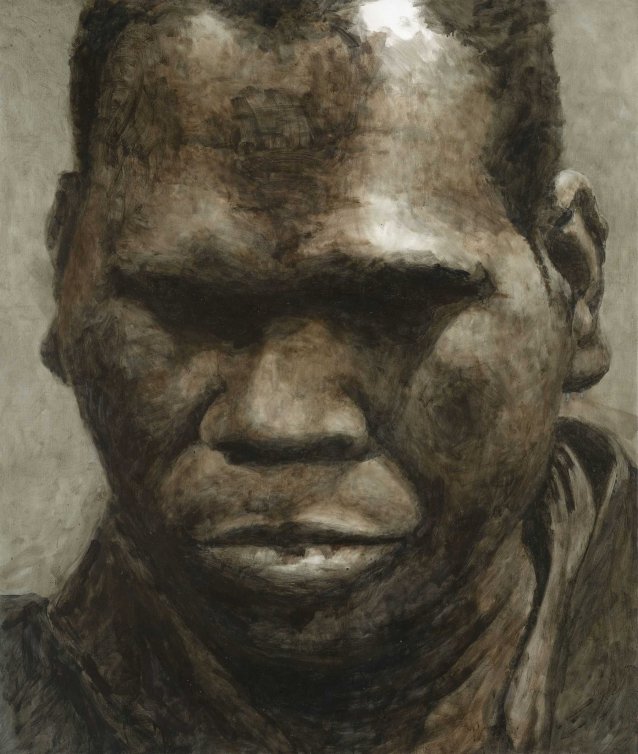Today we will LOOK at the portrait of Dr G Yunupingu by Guy Maestri; THINK about mood and expression in portraiture; READ an article by Ashleigh Wadman; DO a couple of activities and finish with a quiz.
Reducing something to a few core elements can have a very powerful impact. This portrait of Dr G Yunupingu*, a Yolngu man from the Gumatj clan, is painted using just one colour, applied with a consistent brushmark. A monumental musical talent, when Dr G Yunupingu sang in Gumatj he was carrying out his duty of care for his people and the land. After seeing Dr G Yunupingu perform, Maestri arranged a hasty sitting with the musician. He worked on the painting for a month, listening to Dr G Yunupingu’s music as he built layer upon layer. Facial expression in combination with the limited palette contributes to a very evocative portrait – contemplative and strong – perhaps reflecting the impact of the musician’s voice on his audience. Today we will consider mood through technique in looking closely at this portrait.
*We no longer say his full name, because this is the Yolngu way.

Geoffrey Gurrumul Yunupingu, 2009 Guido Maestri. © Guido Maestri
Geoffrey Gurrumul Yunupingu (1970–2017), a Gumatj man from north-east Arnhem Land, was born blind but learned to play guitar, keyboard, drums and didgeridoo as a child. He performed with Yothu Yindi from 1985 to 1992, when he formed the Saltwater Band. Gurrumul shot to prominence in 2008 with the release of his debut album Gurrumul, which was nominated for four ARIAs and won two. Critics raved about his unearthly voice, fusion of music styles and authentic Aboriginal sound and stories. In a cover article Rolling Stone called him 'Australia's most important voice'. Gurrumul sang about Gumatj stories in Yolngu, but his song 'Gurrumul History' was in English, to spread his story. 'I like singing about the story properly, singing all the right names of land, and ancestors, because I have to give out the right story. It is like a celebration.'
Guido Maestri saw Gurrumul perform in Sydney on New Year's Eve 2008 and found it unforgettable. He arranged a hasty sitting with the musician at Sydney airport soon after, taking several sketches and a photograph. Maestri worked on the painting for a month, listening to Gurrumul's music as he built up the image layer upon layer. The portrait won the Archibald Prize for 2009.
Show full caption
Hide full caption
Read
Maestri found Dr G Yunupingu’s performance unforgettable and recalled that, ‘word had been going around all day and the rumours were true – people really were moved to tears’.
Read the Portrait article Yolngu Boy by Ashleigh Wadman.
Solo Activity
Shadows and highlights create mood in this portrait. This is a gentle activity. Immerse yourself in listening, looking and drawing.
You will need: paper; pencil; music
- Go to these recordings of Dr G Yunupingu on YouTube and select a song.
- Listening to Dr G Yunupingu’s dulcet tones, look closely at Guy Maestri’s portrait of the singer. Close your eyes and, with the music still playing, imagine painting this large, evocative monotone portrait.
- If you have black paper and a white pencil, draw the portrait focusing on the highlights.
- If you are using white paper and a graphite pencil, draw the portrait focusing on the shadows.
Connected activity
Do you think you can draw something based purely on someone’s description? It’s not as easy as you might imagine!
You will need: paper; pencil
- Call a friend, and, should they accept the challenge, they will also need paper and a pencil.
- If you are on a video call, ask your friend to angle their camera so that you can see their paper too. If you are on a voice call this step doesn’t matter.
- While your friend is gathering their materials, select a portrait from the National Portrait Gallery website. Don’t reveal which portrait you are looking at.
- Describe the portrait so that your friend can draw it from your description only. There are no other rules, so they are welcome to ask questions.
- Swap. Now it is your turn to draw and your friend’s turn to describe.
Quiz
Next lesson
10. Symbol crash: Identity and representation















